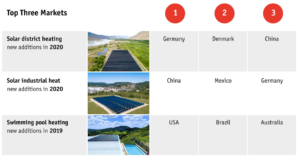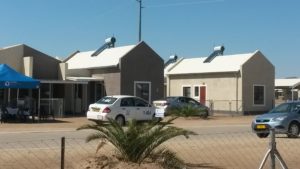Spotlight on the South African solar thermal market
June 6, 2023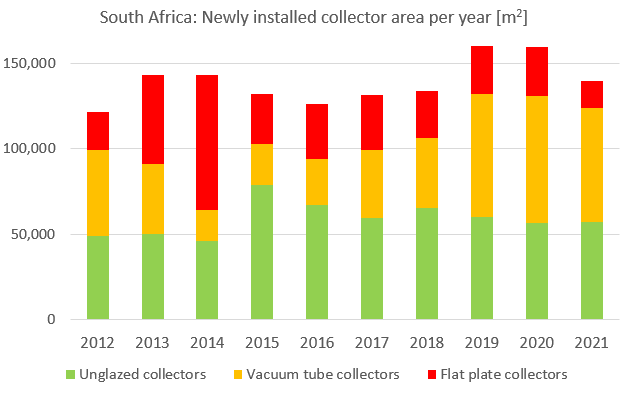
Over the last decade the South African solar thermal market has stagnated at around 140,000 m2 of newly installed collector area annually. On the one hand, South Africa is the largest national solar thermal market on the African continent. On the other hand, this is a surprisingly low volume in a very sunny country with a national building code in place, regular shut downs of the electricity grid and increasing electricity prices. Reasons for the low performance include the generally weak economy. But also the popularity of heat pumps in the housing industry to fulfil the building regulations and the competition from direct PV hot water systems, which are easier to install than solar thermal water heaters. The carbon tax for large industrial heat consumers could now stimulate sales for industry-scale solar water heaters. Currently, there is no national subsidy scheme in place for solar water heaters. Only Soltrain – the Southern African Solar Thermal Training and Demonstration Initiative – supports the installation of larger solar thermal systems for social institutions and industrial clients. South Africa has been a member of the IEA Solar Heating and Cooling Programme since 2010.
Source: Various editions of Solar Heat Worldwide
Market development
The South African solar thermal market is dominated by small residential systems. They are either used to heat private swimming pools or for hot water preparation. Large commercial systems above 50 m2 are rare. Two such systems are described in the section below.
Around 40 % of new sales in South Africa over the past five years have been unglazed collectors for private swimming pools. The technology is provided by only a handful of suppliers. Sales of vacuum tube collectors have increased from around 30 % in 2017 and 2018 to 47 % in 2021 because of cost benefits in direct thermosiphon systems compared with flat plate collectors. The panels are mostly imported from India and China. While in the early years only specialised resellers and installers have been active in this field, most plumbers are now installing solar swimming pool systems and solar water heaters. Flat plate collectors from local manufacturing units have decreased in sales and there are only a small number of manufacturers left.
The large majority of the households that have a water heating device use an electric “geyser”, which is the name used for a boiler in South Africa. Housing insurance plays a significant role in the private appliances market. It insures the failure of a geyser or a solar water heater system. In this case the installer usually replaces what is already installed in the household and the insurance pays for it. If a household decides to replace a broken electric boiler with a solar water heater, they have to pay for the additional installation work themselves.
| New additions in 2021 | 139,951 m2 / 99 kW |
| Compound Annual Growth Rate 2017 to 2021 | 2 % |
| Total solar thermal capacity in operation at the end of 2021 | 2.62 million m2 / 1,844 MW |
| Total capacity in operation at the end of 2021 per 1,000 inhabitants | 44 m2 / 1,000 inhabitants
31 kW / 1,000 inhabitants |
Key figures of the South African solar thermal market for glazed and unglazed collectors. South Africa’s population was used in the calculations at around 60 million. Replacement of existing systems after an estimated lifetime of around 15 years in not considered in South Africa, because the annual market statistics started only 12 years ago. The annual newly installed collector area is therefore added 100 % to the total in operation. Source: Solar Heat Worldwide / Stellenbosch University
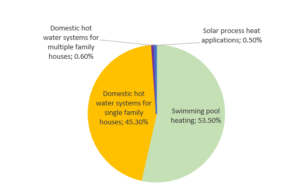
Area of application for total installed collector area at the end of 2021. Source: Solar Heat Worldwide
Large flagship solar thermal projects
Thanks to the support from Soltrain, two flagship projects were installed and inaugurated in 2019. A 600 m² flat plate collector array was installed on the roof of a building at Witwatersrand University in Johannesburg as the first solar district heating system in Sub-Saharan Africa. It meets hot water demand in 14 buildings, which accommodate about 1,100 medical students, who need an average of 94,000 litres a day.
The second demonstration plant was put up at the Klein Karoo tannery in Oudtshoorn, 400 km east of Cape Town. The system meets 55 % of the tannery’s heating needs. Tanneries need temperatures of between 35 °C and 60 °C, making flat plate collectors ideal for this sort of application.
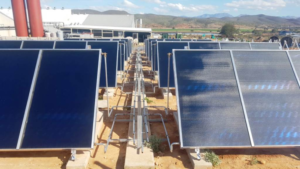
The 600 m2 of collectors installed at Klein Karoo meet 55 % of the tannery’s heating needs. Photo: E3 Energy
Building code compliance with heat pumps
The energy building regulation within the South African National Standard SANS10400 XA came into effect in September 2014 and was the great hope of the solar thermal industry at that time. Part XA2 reads: “A minimum volume fraction of 50 % of the annual average heating requirement for hot water shall be provided by means other than electric resistance heating or fossil fuels.” Solar thermal system suppliers report that the regulation is mostly fulfilled by air-water heat pumps, especially in new buildings. Compliance with the building regulation is the requirement for the property owner to receive an occupancy licence. Without this licence you cannot move into the building or sell it.
Part XA also lists a number of technologies which fulfil the criteria of non-electric hot water supply to newly built and refurbished premises.
- Solar heating with solar collectors or PV panels
- Heat pumps with appropriate storage capacity
- Geothermal heat
- Renewable combustible fuel, e.g., landfill gas, commercially grown types of wood
- Heat recovery from alternative systems and processes
The housing industry opts for heat pumps because they are supposedly easier and faster to install. There are also unfavourable dimensioning rules for solar thermal systems. The building regulation refers to the compulsory specification for solar water heaters, which stipulates a relatively high storage volume of 50 litres per person in the house. So the solar thermal solution needs to have 100 litres per bedroom resulting in a relative costly solution. Hot water systems consisting of a PV generator and an electric element – so called PV2heat systems, however, can be designed flexibly according to the building code.
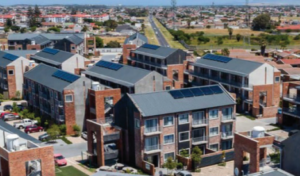
Innovative social housing project supported by Soltrain: The new residential development located in the southern suburbs of Cape Town with 356 apartments was designed to incorporate water and energy-saving features. The national building code was fulfilled by 343 m2 of evacuated tube collector area installed on the different roofs together with a 46,000 litre storage tank. Photo: Melville Place Residential Development
PV on the increase in the residential sector
PV2heat systems are becoming more and more popular in South Africa. They consist of a PV system with an electric element in a storage tank that converts the DC solar electricity directly into heat. So no converter is used. That makes the PV2heat cheaper than PV for electricity supply The systems do not include a storage battery but heat the hot water tank only during sunny hours.
The advantage is that only electrical cables have to be routed from the roof and the system cannot overheat in summer and does not freeze in winter. The disadvantage is that the PV area needed on the roof is three times larger than the collector area of a solar thermal water heater.
Through the Soltrain project the Centre for Renewable and Sustainable Energy Studies (CRSES) at the Stellenbosch University collected data between 2018 and 2020 on PV2heat installations in South Africa. At the end of 2018 there were an estimated 2,400 PV2heat systems installed in the country. The number grew to 11,700 systems installed by December 2022. The authors of the Solar Heat Worldwide study estimated that the installed PV2heat systems added up to a total PV capacity of 9,869 kW at the end of 2020, indicating an average PV capacity per system of 850 Wp.
Carbon tax stimulates solar process heat market
The carbon tax for large energy consumers in place since June 2019 started its second phase at the beginning of 2023. The rate of carbon tax in 2022 was 144 ZAR per ton of CO2 emissions and will increase annually with the consumer price inflation. Therefore, the carbon tax rate increased to 159 ZAR per kg CO2 emissions in 2023. All industrial users with an energy (heat and electricity) producing capacity of at least 10 MW are covered by this law. Solar project developers observe a certain willingness to invest in emission-saving measures like solar thermal systems to avoid tax payments.
The situation will worsen for energy-intensive industry in 2023 because tax-free emission allowances, which reduced the tax burden in the first phase, will be reduced.
EU‘s Carbon Border Adjustment Mechanism could provide another positive push for the greening of the heat demand in South Africa´s export industry. Importers of goods to Europe must report the carbon foot print of their products for the first time in January 2024.
The carbon tax and the Carbon Boarder Adjustment Mechanism will therefore both stimulate demand for solar process heat systems in the long term. The accompanying measures such as training and subsidies from Soltrain+ will also have a positive effect here. The Austrian Development Agency (ADA) will finance another four years of capacity building and demonstration plants with a special focus on solar industrial heat. Soltrain+ will again be managed by AEE INTEC, which started the initiative 13 years ago.
Websites of organisations and projects mentioned in this news article:
IEA SHC Programme: https://www.iea-shc.org/
Soltrain+: https://soltrain.org/news/announcing-soltrain-plus
Solar Heat Worldwide: https://www.iea-shc.org/solar-heat-worldwide
Carbon Tax Act 15 from June 2019: https://www.gov.za/sites/default/files/gcis_document/201905/4248323-5act15of2019carbontaxact.pdf
National Building Regulations: https://sans10400.co.za/wp-content/uploads/2013/11/A-Guide-to-SANS-10400XA.pdf
Further news about the South African solar thermal market:
Building regulation not applied as intended from February 2015
Building regulations and electricity prices drive market from April 2019
Region with high solar ambitions joints IEA SHC from July 2022
First SDH system in Sub-Saharan Africa from May 2019

